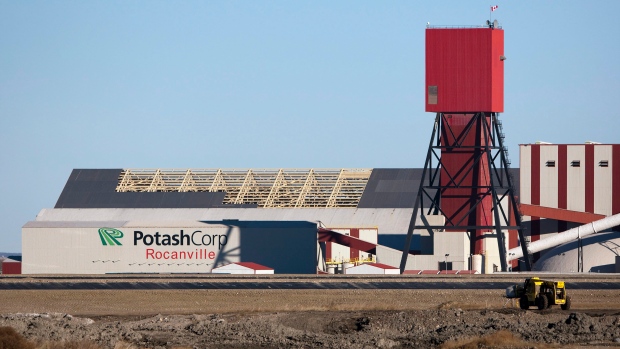Jul 28, 2016
Potash Corp slashes dividend 60%, cuts full-year forecast again
, Reuters

Potash Corp of Saskatchewan (POT.TO, POT.N), the world's biggest fertilizer company by capacity, cut its full-year profit forecast and dividend for the second time this year on Thursday, and said that potash markets had reached their low point.
Prices for the crop nutrient have fallen to their lowest in about a decade, weighed down by excessive mining capacity and soft demand in key export markets.
“We believe the uncertainty that weighed on potash market sentiment is now lifting and a recovery is beginning," Chief Executive Jochen Tilk said in a statement.
Potash plans to cut its quarterly dividend to 10 cents per share from 25 cents. Its shares fell 4.7 per cent in New York and Toronto, and the U.S.-listed stock touched a two-week low of US$16.32, down 40 per cent in the past 12 months.
Potash Corp "could sit at the bottom here for another year," said Bryden Teich, portfolio manager at Avenue Investment Management, which sold its Potash position in late June.
"A year out, the fundamentals for the potash market still look murky," he said.
Canpotex Ltd, the export company owned by Potash, Mosaic Co and Agrium Inc, is still negotiating a second-half supply contract with Chinese buyers, Potash said, unlike some rivals who have struck agreements.
Canpotex has reached deals with Indian buyers for shipments during the next three months, Potash said.
Tilk said the company sees potential for record demand in 2017 of 61 million to 64 million tonnes.
Potash cut its full-year profit forecast to a range of 40 to 55 cents, from the 60 to 80 cents it forecast in April.
The company maintained its forecast for full-year potash sales volumes in the range of 8.3 million to 8.8 million tonnes but said it expected lower prices earlier in the year to weigh on results.
Potash's net earnings fell to US$121 million, or 14 cents per share, in the second quarter ended June 30 from US$417 million, or 50 cents per share, a year earlier, pressured by weaker-than-expected prices.
The company's average realized potash price fell 44 per cent year over year to US$154 per tonne during the quarter.
On an adjusted basis, earnings were 18 cents per share, in line with expectations. Sales fell 39 per cent to US$1.05 billion.
Analysts on average had expected revenue of US$1.18 billion, according to Thomson Reuters.
Despite continued weakness in potash prices, Potash Corp chief executive Jochen Tilk has been upbeat about a recovery in demand year after year. Here’s a look back at what he’s said:
Oct. 29, 2015
"Despite challenges over recent months, we are seeing signs of a shift in focus by distributors and farmers to 2016 … We believe the need for increased global agricultural production – coupled with supportive crop prices – provides a compelling opportunity for farmers."
July 30, 2015
“Our earnings for the quarter hit the midpoint of our guidance range but trailed last year’s total, primarily due to weaker nitrogen prices … While we have faced some near-term market headwinds, we are encouraged by the strength of global potash demand, especially in offshore markets.”
April 30, 2015
“Looking ahead, we are encouraged by the strength in global potash demand and see momentum accelerating through the second quarter, especially in offshore markets"
Jan. 29, 2015
“As we look ahead, we see a supportive market environment – most notably in potash. We are ready to respond should demand for this nutrient prove stronger than expected…”
Jan. 30, 2015
"Pricing headwinds – most notably in potash – weighed on our performance, although there were signs as the quarter came to a close that the uncertainty in global markets was beginning to abate.”
July 25, 2013
“Rising global demand for all three crop nutrients continues to reflect the underlying reality that farmers and fertilizer buyers around the world are working to improve soil fertility and food production.”
Oct. 25, 2012
“We believe the nature of food production necessitates that fertilizer demand will return in all major markets.”
Jan. 26, 2012
“The return on fertilizer investment continues to be attractive to farmers world-wide and is expected to result in greater demand in the quarters ahead.”
Jan. 28, 2011
"Our industry moved past an important inflection point in the third quarter and, as farmers around the world became more active in addressing the critical issue of soil fertility, we demonstrated our ability to deliver in a strengthening market environment."
Jan. 22, 2010
"We believe the need for more food – and the nutrients to produce it – is irrefutable … Even though fertilizer demand can be deferred on a short-term basis, as we saw in 2009, the long-term requirement cannot be denied. We enter 2010 with a sense of optimism, as we look ahead to helping fertilizer dealers and farmers begin replenishing nutrients in the soil and supply chain.”
Jan. 22, 2009
“With our focus on potash, the nutrient with the strongest fundamentals, we anticipate even greater opportunities ahead and will continue to build capacity to meet future growth in demand.”
Compiled by BNN


